

The cognitive neuroscience of lucid dreaming. Brain Change in Addiction as Learning, Not Disease. Addiction and the Brain: Development, Not Disease. I review the brain disease model of addiction promoted by medical, scientific, and clinical authorities in the US and elsewhere.
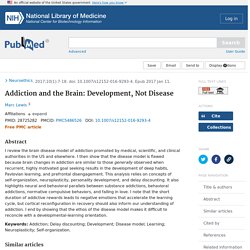
I then show that the disease model is flawed because brain changes in addiction are similar to those generally observed when recurrent, highly motivated goal seeking results in the development of deep habits, Pavlovian learning, and prefrontal disengagement. Molecular Mechanisms of Learning and Memory. History of psychosurgery. History of psychosurgery. Psychosurgery, also called neurosurgery for mental disorder or functional neurosurgery, is surgery in which brain tissue is destroyed with the aim of alleviating the symptoms of mental disorder.

It was first used in modern times by Gottlieb Burckhardt in 1891, but only in a few isolated instances, not becoming more widely used until the 1930s following the work of Portuguese neurologist António Egas Moniz. The 1940s was the decade when psychosurgery was most popular, largely due to the efforts of American neurologist Walter Freeman; its use has been declining since then. Freeman’s particular form of psychosurgery, the lobotomy, was last used in the 1970s, but other forms of psychosurgery, such as the cingulotomy and capsulotomy have survived. Contents Early history 1 1930s 2 1940s 3 1950s and 1960s 4 1970s to the 1980s 5 1990s to the present 6 Effects 7 Ethics 8 See also 9 References 10 Early history 1930s 1940s 1950s and 1960s 1970s to the 1980s 1990s to the present Effects.
Lesion Techniques for Behavioral Experiments. David G.
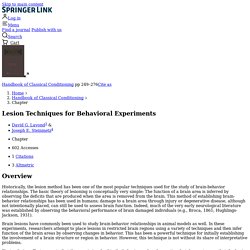
LavondJoseph E. Steinmetz David G. Lavond1Joseph E. Steinmetz21.University of Southern CaliforniaLos AngelesUSA2.Indiana UniversityBloomingtonUSA Overview. Neuroimaging News, Articles. Motivational Disorders in Brain Conditions. Several years ago, neurologist Masud Husain of the University of Oxford received an unusual referral letter from a general practitioner, describing a 41-year-old man who had, according to his friends, become extremely boring after suffering a stroke.
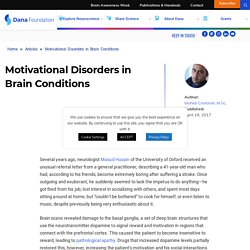
Types of Motives: Biological, Social and Personal Motives. Psychologists have divided motives into three types—Biological motives, social motives and personal motives!
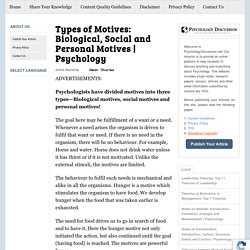
The goal here may be fulfillment of a want or a need. Whenever a need arises the organism is driven to fulfil that want or need. If there is no need in the organism, there will be no behaviour. For example, Horse and water. Horse does not drink water unless it has thirst or if it is not motivated. Are the Neural Correlates of Consciousness in the Front or in the Back of the Cerebral Cortex? Clinical and Neuroimaging Evidence. Frontiers - Search. Psychiatria Polska - 1181Z.
Psychiatr.

Pol. 2017; 51(6): 1181–1189 DOI: Cezary Żechowski FREE POLISH FULLTEXT: Teoria emocji i popędów – od Sigmunda Freuda do Jaaka Pankseppa FREE ENGLISH FULLTEXT: Theory of drives and emotions – from Sigmund Freud to Jaak Panksepp Summary. Reasoning, Attention and Memory. The machine learning community has had great success in the last decades at solving basic prediction tasks such as text classification, image annotation and speech recognition.
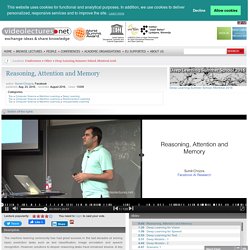
However, solutions to deeper reasoning tasks have remained elusive. A key component towards achieving deeper reasoning is the use of long term dependencies as well as short term context during inference. Until recently, most existing machine learning models have lacked an easy way to read and write to part of a (potentially very large) long-term memory component, and to combine this seamlessly with inference. To combine memory with reasoning, a model must learn how to access it, i.e. to perform *attention* over its memory.
Within the last year or so, there has been some notable progress in this area however. Would you like to put a link to this lecture on your homepage? Med.harvard.edu/AANLIB/cases/caseNA/pb9.htm. Interactive Brain. Brain lobes - annotated MRI. Free Anatomy Quiz - The anatomy of the Brain, Quiz 1. Nervous System - Label the Brain. University of Illinois. Deep Brain Structures: Coronal Section - 3D model by INTERVOKE (@intervoke) [1295476] University of Illinois. BrainFacts. In Chapter 09: Motivation and Emotion. You must turn off your ad blocker to use Psych Web; however, we are taking pains to keep advertising minimal and unobtrusive (one ad at the top of each page) so interference to your reading should be minimal.

If you need instructions for turning off common ad-blocking programs, click here. If you already know how to turn off your ad blocker, just hit the refresh icon or F5 after you do it, to see the page. Summary: Biological Motives Biological motives include hunger, thirst, the pursuit of pleasure, and the avoidance of pain. An early attempt to specify how these motives affect animal behavior was the ambitious theory of Clark Hull. Hull borrowed from the concept of homeostasis or biological regulation.
Modern theories of hunger involve multiple factors. Pleasure and pain are regulated by a hedonic control system. The neurotransmitter dopamine is involved in neural pathways to the prefrontal cortex of humans, a key area for pursuing goals. Write to Dr. The science of motivation. Kou Murayama is an associate professor at the University of Reading, heading the multidisciplinary Motivation Science lab with the aim of achieving an integrative understanding of human motivation.
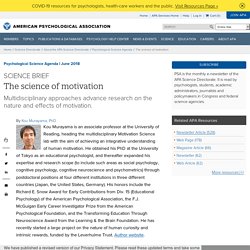
He obtained his PhD at the University of Tokyo as an educational psychologist, and thereafter expanded his expertise and research scope (to include such areas as social psychology, cognitive psychology, cognitive neuroscience and psychometrics) through postdoctoral positions at four different institutions in three different countries (Japan, the United States, Germany). His honors include the Richard E. Snow Award for Early Contributions from Div. 15 (Educational Psychology) of the American Psychological Association, the F.J.